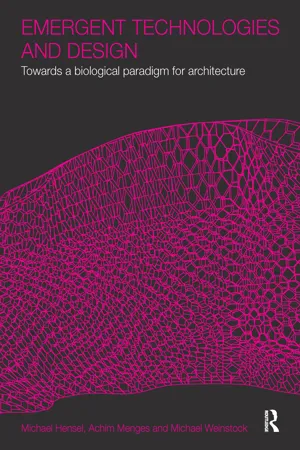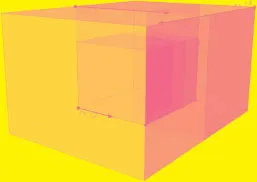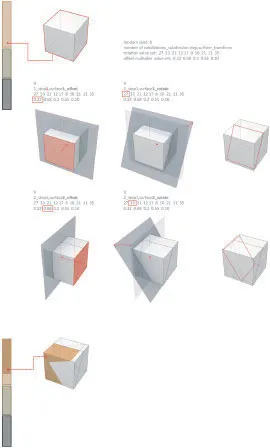![]()
Part 1
Theoretical framework
![]()
Chapter 1
Evolution and computation
Michael Weinstock
1.1
Spatial subdivision algorithm (SSD): An offset operation is performed using multiple faces (red quad) of a three-dimensional polygon (white) to accommodate a pre-defined program hierarchy (2D-program bar). After each offset a rotation of the resulting cutting plane (grey 2D plane) is performed and the polygon solid is subdivided into smaller volumes. The program is inserted (yellow) based on optimal size and proximity to similar program classification. The algorithm repeats to distribute the various classifications of program utilising local geometric definitions of the polygonal solids. Offset and rotation values are determined by cycling systematically through a limited set of numbers. Each assembly of uniquely subdivided volumes is generated through using only nine rotation values and five offset values. Emergence seminar research by Sean Ahlquist and Moritz Fleischmann, 2008.
Architecture is undergoing a systemic change, driven by the changes in culture, science, industry and commerce that are rapidly eroding the former boundaries between the natural and the artificial. The conceptual apparatus of architecture has always given a central role to the relations of mankind and nature. The human body has been a source of harmonious proportions and the shapes of many living organisms have been adapted for architectural use. The current widespread fascination with nature is a reflection of the availability of new modes of imaging the interior structures of plants and animals, of electron-microscopy of the intricate and very small, together with the mathematics of biological processes. New working methods of architectural design and production are rapidly spreading through architectural and engineering practices, as they have already revised the world of manufacturing and construction. The material practices of contemporary architecture cannot be separated from this paradigm shift in the context within which architecture is conceived and made. The study of natural systems suggests the means of conceiving and producing architecture that is more strongly correlated to material organisations and systems in the natural world.
Computational form-generating processes are based on ‘genetic engines’ that are derived from the mathematical equivalent of the Darwinian model of evolution, and from the biological science of evolutionary development that combines processes of embryological growth and evolutionary development of the species. Evolutionary computation offers the potential for relating pattern and process, form and behaviour, with spatial and cultural parameters. Evolutionary computational strategies for morphogenesis have the potential to be combined with advanced structural and material simulations of behaviour under stresses of gravity and load. This approach is part of the contemporary reconfiguration of the understanding of ‘nature’, a change from metaphor to model, from ‘nature’ as a source of shapes to be copied to ‘nature’ as a series of interrelated dynamic processes that can be simulated and adapted for the design and production of architecture.
The development and use of computational systems for architectural design is central to the theoretical and experimental explorations of the Emergent Technologies and Design programme. The seminar courses ‘Emergence’ and ‘Biomimetics and Natural Systems’ introduce the origins and instruments of the sciences and technologies associated with emergence, commencing with Darwin and D’Arcy Thompson, through analysis of the mathematical logics of evolution and biological development, to the experimental development of evolutionary algorithms within the limited computational environment of architectural design software.
1.2
The program hierarchy, based on position and size in the 2D-program bar (input 1), applied to a cubic three-dimensional polygon (input 2, white) results in a highly differentiated accumulation of sub-volumes (yellow, green, grey). As the grey program was defined as a ‘void space’, it is deleted in the final result. Emergence seminar research by Sean Ahlquist and Moritz Fleischmann, 2008.
EVOLUTION AND DEVELOPMENT
The development of ‘evolutionary’ algorithms commences with an understanding of the two distinct but coupled processes that bring about the morphogenesis, variation and distribution of all living forms. Every living form emerges from two strongly coupled processes, operating over maximally differentiated time spans: the rapid process of embryological development from a single cell to an adult form, and the long slow process of the evolution of diverse species of forms over multiple generations. Fossil evidence suggests that the history of biological evolution is a sequence, from simple cell organisms to the higher complexity of plants and animals. Charles Darwin argued that all living and extinct beings were the offspring of common parents, ‘descended from an ancient progenitor’, and that ‘all past and present organic beings constitute one grand natural system’. The diversification and proliferation of all living forms, the historical development of all the species of life, was driven by variation and selection. ‘I have called this principle, by which each slight variation, if useful, is preserved, by the term Natural Selection’ (Darwin 1859: 61). In Darwin’s view variations are random, small modifications or changes in the organism that occur naturally in reproduction through the generations. Random variation produces the raw material of variant forms, and natural selection acts as the force that chooses the forms that survive. Just as humans breed livestock and vegetables by ‘unnatural’ selection, methodically organising systematic changes in them, so wild organisms themselves are changed by natural selection, in a slow, steady, gradual and continuous process of change. Darwin did not, as is sometimes said, assume that selection was the only mechanism of evolutionary change. In the last sentence of the introduction to The Origin of the Species he wrote: ‘I am convinced that Natural Selection has been the most important, but not the exclusive, means of modification’ (Darwin 1859: 6).
The development of a single being from an embryo to an adult form was at that time regarded as related to but distinct from the evolutionary ‘descent from ancestors’. Darwin stated that ‘the early cells or units possess the inherent power, independently of any external agent, of producing new structures wholly different in form, position, and function’ (Darwin 1859: 389). His account of the properties of cells included their ability to proliferate by division, and to differentiate themselves to form the various tissues of a body. Almost a hundred years later Gould published Ontogeny and Phylogeny (Gould 1977), in which he argued that all changes in form are the result of changes to the timing of the developmental processes relative to each other, and to the rate at which they are carried out. His synthesis of embryological development and evolution was focused on changes in the timing and rate of development.
At the end of the nineteenth century William Bateson published a substantive account of the mutations in living forms, Material for the Study of Variation (Bateson 1894). Bateson’s interest lay in how living forms come into being, how they are adapted to ‘fit the places they have to live in’, and in the differences between forms, and particularly in the causes of variation. Although an admirer of Darwin, he believed that the process of evolution was not one of continuous and gradual modification, but was rather discontinuous. New forms and species could not come into being through a gradual accumulation of small changes, and distinct parts arose or disappeared rapidly. He argued that distinctive variations, entire new forms, could spring up, already perfectly adapted. His argument rests on his analysis of the morphology of living beings, observing that ‘the bodies of living things are mostly made up of repeated parts’, organised bilaterally or radially in series, and many body parts themselves are also made up of repeated units. The parts are already functional, pre-adapted so to speak, so that morphological changes or variations can occur by changes to the number or order of parts. Another common variation he named ‘homeotic’, in which one body part is replaced by or transformed into a likeness of another part, for example appendages such as legs and antennae that have similar morphological characteristics. He regarded most variations between species as differences in the spatial arrangement, number and kind of repeated parts or modules. Furthermore, he thought that these changes were initiated during the development of the embryo by fluctuations in ‘force’. He described this force, to much derision at the time, as rhythmic or ‘vibratory’, harmonic resonances or similar wave-like phenomena capable of dynamic response to environmental changes. Discontinuity in evolution is suggested by the fossil evidence, which implies long periods of relative stasis punctuated by sudden short periods in which many new species appear (Eldredge 1995). Gould’s ‘punctuated equilibrium’ is perhaps the best known, if not most widely accepted, version of the theory that forms tend to persist unchanged for great lengths of time, and undergo brief but rapid change to produce new species in response to severe changes in their environment.
D’Arcy Thompson agreed with Darwin’s argument that natural selection is efficient at removing the ‘unfit’, but in his view all forms are influenced by the physical properties of the natural world, and the form of living things is a diagram of the forces that have acted on them (Thompson 1917). The physical forces act on living forms and determine the scales, bounding limits and informing geometries of the development of all adult forms. Evolution and differential growth during the process of development produce the material forms of living things. The combination of the internal forces such as chemical activities and the pressure in their cells, and the external forces of the environment such as gravity, climate and the available energy supply determine the characteristics of the field in which they act; the effect of these natural forces is expressed in different ways depending on the size of the organism. ‘Cell and tissue, shell and bone, leaf and flower, are so many portions of matter, and it is in obedience to the laws of physics that their particles have been moved, moulded and conformed’ (Thompson 1917). His recognition of growth as the principal means of achieving variation in inherited forms predates Gould’s synthesis, but most significantly, D’Arcy Thompson proposed that ‘a new system of forces, introduced by altered environment and habits’ would, over time, produce adaptive modifications of forms. Living forms, like nonliving forms, exist in a field of forces, and alterations in those forces will inevitably produce the response of evolutionary changes to forms. Furthermore, these changes will be systemic, to the whole being rather than to a specific part, ‘more or less uniform or graded modifications’ over the whole of the body (Thompson 1917).
Animals and plants that have quite different evolutionary lineages may have striking similarities in the general organisation of their body parts, their anatomical structures, and the processes of their organs. Common organisations and anatomical architectures emerge from the coupling of processes that are strongly differentiated in time and by scale: slow processes acting over multiple generations, and very fast processes acting only in the short period of embryological development (Berril and Godwin 1996). In the first process, some biological forms, structures and metabolic processes are better able than others to withstand the physical stresses of the world, the rigours of the environment and the competitions of life. Natural selection will gradually tend to produce a generalised response of adaptation to specific environmental stresses, and this will occur across many species. Over sufficient time, forms will tend to converge. In the second process, the genome acts on the construction of individual forms. The accumulated complexity of the genome manifests in a general tendency to initiate cellular differentiation along common sequences and pathways. Common sequences of development, in a stress field that all developing organisms share, tend to lead to rather generic outcomes.
Furthermore, a large portion of the genome is similar across groups of species, and the sequence of development is also similar, as is the molecular chemistry of the biological materials of which living forms are constructed. All materials experience the same physical forces, are subject to the same stresses and react in similar patterns. Small variations in the sequence of inhibition and acceleration or in the duration of either inhibition or acceleration may produce changes in the development of the embryo at many scales, through the reorganisation and recombination of biological components.
INFORMATION AND MUTATION
Genetic information passing down through the generations modifies the forms of living beings and their interaction with their environment and the materials and energy that they extract from it. As each generation succeeds its ancestors, information is propagated down through time. Changes or modifications to living forms occur both by mutation or ‘copy errors’, and by the recombination of existing information into new sequences and patterns. This may be seen in evolution in general, in the emergence of new species, and in the emergence of social or collective behaviour and material constructions of insects, animals and humans. Energy and information produce effects that act upon the architecture of material in space and over time, and the interaction between them is neither exclusively ‘bottom’ up nor ‘top down’. It is clear that both the living forms of nature and the constructed forms of human artefacts emerge from complex processes that are coupled to the transmission of information.
Cultural information is also transmitted down through time, and material practices manifest that information in ...




